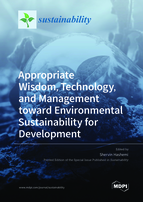Appropriate Wisdom, Technology, and Management toward Environmental Sustainability for Development
A special issue of Sustainability (ISSN 2071-1050). This special issue belongs to the section "Environmental Sustainability and Applications".
Deadline for manuscript submissions: closed (31 December 2021) | Viewed by 101892
Special Issue Editor
Interests: circular economy; conservation and recycling; drinking water management; environmental engineering; environment science; environmental remediation; life cycle assessment; nature-based solutions; public health; risk assessment; sanitation and hygiene; sustainability; waste management; water and wastewater treatment
Special Issues, Collections and Topics in MDPI journals
Special Issue Information
Dear Colleagues,
Protection and maintenance of environmental resources for future generations require responsible interaction with the environment to avoid wasting natural resources. An ancient Native American proverb says, “we do not inherit the Earth from our ancestors; we borrow it from our children”. This indigenous wisdom could certainly substantially define the meaning of environmental sustainability.
Advances in technologies in recent times could sustain humankind and allow living in comfort. However, not all of these advances may sustain the environment for later generations. Developing societies along with keeping the ecosystem sustainable require appropriate wisdom, technology, and management working together.
The Special Issue (SI) entitled “Appropriate Wisdom, Technology, and Management toward Environmental Sustainability for Development” is proposed for the “Sustainable Use of the Environment and Resources” section of the journal Sustainability.
This SI aims to publish relevant studies on approaches toward environmental sustainability. It appeals for original and novel studies on the provision of responsible consumption, reasonable recycling, and sustainable development of natural resources in different types of environments, including the anthroposphere, atmosphere, biosphere, hydrosphere, and lithosphere. Priority will be given to the works based in developing countries.
Studies in the areas and fields below are highly encouraged for consideration. In their cover letter, authors should mention to which of the fields below their study corresponds.
- Appropriate Wisdom
- Resource Valorization: Valuing Water, Wastes, and Other Resources
- Development of Mathematical, Theoretical, and Computational Models
- Scientific Hypothetical Approaches
- Analyzing Historical Approaches and Ancient Wisdom
- Appropriate Technology
- Nature-Based Solutions
- Clean Technologies
- Resource Circulation: Conservation and Recycling
- Appropriate Management
- Human ↔ Nature Interactions: Simulation and Optimization
- Economic Management: Life Cycle Assessment (LCA) and Circular Economy
- Social Awareness and Human Rights: Concepts of Leaving No One Behind
- Sanitation, Hygiene, and Public Health
- Risk Assessment
- New Policies
- Any Other Relevant Topic (should be consulted with the editor)
Submissions are welcomed as Articles and Reviews. The “Instructions for Authors” provided by the journal Sustainability should be carefully followed by the authors to prepare their submissions. The SI follows the policies of the journal Sustainability thoroughly regarding submission, reviewing process, and publication.
Dr. Shervin Hashemi
Guest Editor
Manuscript Submission Information
Manuscripts should be submitted online at www.mdpi.com by registering and logging in to this website. Once you are registered, click here to go to the submission form. Manuscripts can be submitted until the deadline. All submissions that pass pre-check are peer-reviewed. Accepted papers will be published continuously in the journal (as soon as accepted) and will be listed together on the special issue website. Research articles, review articles as well as short communications are invited. For planned papers, a title and short abstract (about 100 words) can be sent to the Editorial Office for announcement on this website.
Submitted manuscripts should not have been published previously, nor be under consideration for publication elsewhere (except conference proceedings papers). All manuscripts are thoroughly refereed through a single-blind peer-review process. A guide for authors and other relevant information for submission of manuscripts is available on the Instructions for Authors page. Sustainability is an international peer-reviewed open access semimonthly journal published by MDPI.
Please visit the Instructions for Authors page before submitting a manuscript. The Article Processing Charge (APC) for publication in this open access journal is 2400 CHF (Swiss Francs). Submitted papers should be well formatted and use good English. Authors may use MDPI's English editing service prior to publication or during author revisions.
Keywords
- appropriate technology
- nature-based solutions
- resource valorization
- sustainability






